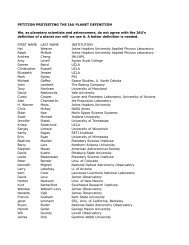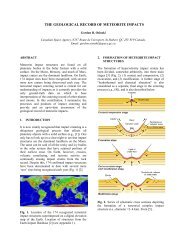Instrument calibration of the Hayabusa near-infrared spectrometer
Instrument calibration of the Hayabusa near-infrared spectrometer
Instrument calibration of the Hayabusa near-infrared spectrometer
Create successful ePaper yourself
Turn your PDF publications into a flip-book with our unique Google optimized e-Paper software.
spacecraft chassis in such a way that <strong>the</strong> viewing is fixed in almost <strong>the</strong> spacecraft −Z axis,direction in which opposite <strong>the</strong> solar arrays and high-gain antenna (see Fujiwara et al., 2000).The NIRS optical design, summarized in Figure 1, consists <strong>of</strong> an entrance aperture stop,a field stop slit, two mirrors, a diffraction grating, a camera lens assembly, a detector, and two<strong>calibration</strong> targets. The assembled <strong>spectrometer</strong> is covered with carbon-fiber reinforcedplastic box case (300 × 150 × 100 mm in size). After passing through <strong>the</strong> slit, incident light isdispersed by a grism, transmission diffraction grating, combined with a cross disperser andre-imaged <strong>of</strong>f by a camera optics. The first-order light fall on a 64-elementindium-gallium-arsenide (InGaAs) li<strong>near</strong> detector array that covers <strong>the</strong> range <strong>of</strong> 750-2250 nm,in increments <strong>of</strong> 24 nm. The cross disperser prevents light o<strong>the</strong>r than first-order from reaching<strong>the</strong> detector. NIRS carries <strong>the</strong> two types <strong>of</strong> onboard <strong>calibration</strong> targets, an incandescenthalogen lamp and a light-emitting-diode (LED), for periodic monitoring <strong>of</strong> detector stability.These targets are mounted on <strong>the</strong> aperture plate. The design was developed in accordancewith <strong>the</strong> requirements <strong>of</strong> downsizing and weight saving.Table 1 lists key specifications and characteristics <strong>of</strong> <strong>the</strong> instrument. Note that <strong>the</strong><strong>calibration</strong> LED is fixed outside <strong>of</strong> aperture but <strong>the</strong> lamp is fixed on <strong>the</strong> inner edge <strong>of</strong> apertureso that <strong>the</strong> effective aperture size drop <strong>of</strong>f by ~4%. The slit size was determined as it canprovide an angular field-<strong>of</strong>-view (FOV) <strong>of</strong> 0.1° × 0.1°, which corresponds to <strong>the</strong> spatialresolution <strong>of</strong> 17 m × 17 m at a distance <strong>of</strong> 10 km. A moveable shutter can be used to blockcompletely <strong>the</strong> slit for dark current measurements. The signal in a dark spectrum represents<strong>the</strong> background electronic and o<strong>the</strong>r noise inherent in <strong>the</strong> instrument. A <strong>the</strong>rmoelectric Peltierdevice actively cools <strong>the</strong> InGaAs detector arrays in order to achieve a sufficientsignal-to-noise ratio (SNR). The detector has a built-incomplementary-metal-oxide-semiconductor (CMOS) image sensor, which is used tomultiplex <strong>the</strong> outputs to a single analog to digital (A/D) converter.3. Operating Modes and Data AcquisitionNIRS operation modes are implemented in <strong>the</strong> onboard s<strong>of</strong>tware using instrumentparameters that can be changed by ground operation commands. There are a total <strong>of</strong> fivemodes available to NIRS; NORMAL, RAW, HIST, LIDAR, and FLASH.In <strong>the</strong> NORMAL mode, each observation consists <strong>of</strong> certain sequential sets <strong>of</strong> alternatelight and dark frames (see Figure 2). That is accomplished by chopping-motion <strong>of</strong> <strong>the</strong> shutter,allowing <strong>the</strong> dark current level <strong>of</strong> <strong>the</strong> detector to be subtracted on a channel-by-channel basisevery time. The CMOS image sensor serves to read differences <strong>of</strong> outputs on each detector5


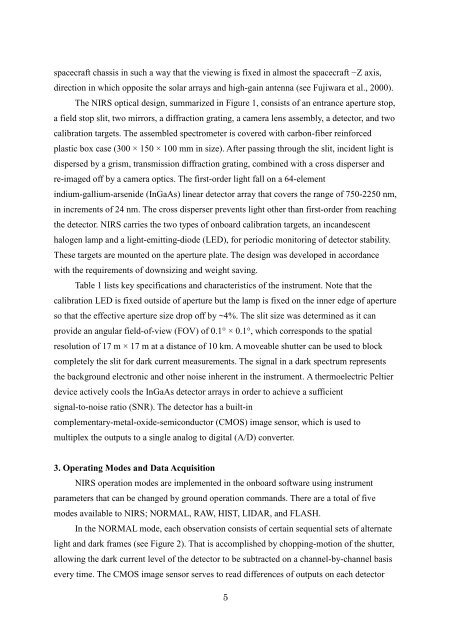
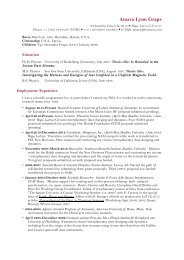

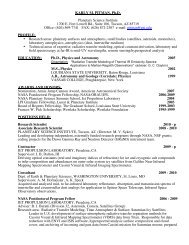
![Large-Aperture [OI] 6300 Ã
Photometry of Comet Hale-Bopp ...](https://img.yumpu.com/37144207/1/190x245/large-aperture-oi-6300-a-photometry-of-comet-hale-bopp-.jpg?quality=85)
